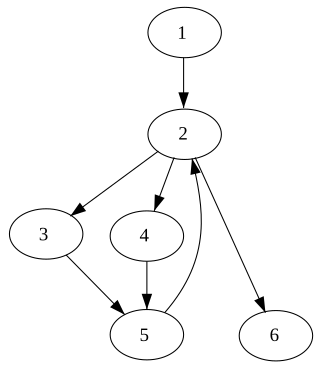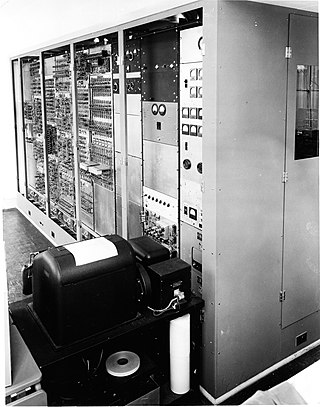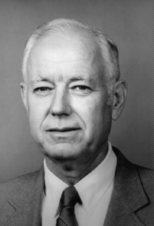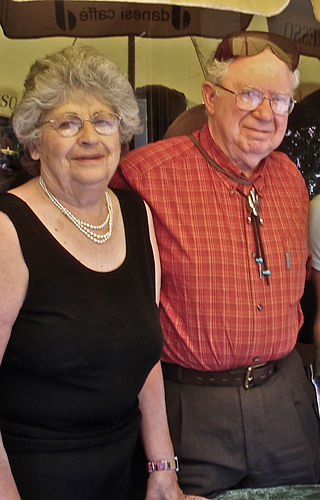Related Research Articles
The Association for Computing Machinery (ACM) is a US-based international learned society for computing. It was founded in 1947 and is the world's largest scientific and educational computing society. The ACM is a non-profit professional membership group, claiming nearly 110,000 student and professional members as of 2022. Its headquarters are in New York City.

The UNIVAC I was the first general-purpose electronic digital computer design for business application produced in the United States. It was designed principally by J. Presper Eckert and John Mauchly, the inventors of the ENIAC. Design work was started by their company, Eckert–Mauchly Computer Corporation (EMCC), and was completed after the company had been acquired by Remington Rand. In the years before successor models of the UNIVAC I appeared, the machine was simply known as "the UNIVAC".
Computer magazines are about computers and related subjects, such as networking and the Internet. Most computer magazines offer advice, some offer programming tutorials, reviews of the latest technologies, and advertisements.

The IAS machine was the first electronic computer built at the Institute for Advanced Study (IAS) in Princeton, New Jersey. It is sometimes called the von Neumann machine, since the paper describing its design was edited by John von Neumann, a mathematics professor at both Princeton University and IAS. The computer was built from late 1945 until 1951 under his direction. The general organization is called von Neumann architecture, even though it was both conceived and implemented by others. The computer is in the collection of the Smithsonian National Museum of American History but is not currently on display.

Peter Gabriel Neumann is a computer-science researcher who worked on the Multics operating system in the 1960s. He edits the RISKS Digest columns for ACM Software Engineering Notes and Communications of the ACM. He founded ACM SIGSOFT and is a Fellow of the ACM, IEEE, and AAAS.

In computer science, a node d of a control-flow graph dominates a node n if every path from the entry node to n must go through d. Notationally, this is written as d dom n. By definition, every node dominates itself.

SEAC was a first-generation electronic computer, built in 1950 by the U.S. National Bureau of Standards (NBS) and was initially called the National Bureau of Standards Interim Computer, because it was a small-scale computer designed to be built quickly and put into operation while the NBS waited for more powerful computers to be completed. The team that developed SEAC was organized by Samuel N. Alexander. SEAC was demonstrated in April 1950 and was dedicated in June 1950; it is claimed to be the first fully operational stored-program electronic computer in the US.

DYSEAC was the second Standards Electronic Automatic Computer.

Woodrow Wilson "Woody" Bledsoe was an American mathematician, computer scientist, and prominent educator. He is one of the founders of artificial intelligence (AI), making early contributions in pattern recognition and automated theorem proving. He continued to make significant contributions to AI throughout his long career.

Rodnay Zaks is a French-born American author of many books on computer programming, including the seminal Programming the Z80 and Programming the 6502. He is the founder of independent computer book publisher Sybex and was its president and chief executive officer (CEO) until its takeover by John Wiley & Sons in May 2005.

Gerald Estrin was an American computer scientist, and professor at the UCLA Computer Science Department. He is known for his work on the organization of computer systems, on parallel processing and SARA.
A distributed operating system is system software over a collection of independent software, networked, communicating, and physically separate computational nodes. They handle jobs which are serviced by multiple CPUs. Each individual node holds a specific software subset of the global aggregate operating system. Each subset is a composite of two distinct service provisioners. The first is a ubiquitous minimal kernel, or microkernel, that directly controls that node's hardware. Second is a higher-level collection of system management components that coordinate the node's individual and collaborative activities. These components abstract microkernel functions and support user applications.
Bruce Gilchrist is considered one of the notable figures in modern computing history.
"Man-Computer Symbiosis" is the title of a work by J. C. R. Licklider, which was published in 1960. The paper represented what we would today consider a fundamental, or key text of the modern computing revolution.
The American Federation of Information Processing Societies (AFIPS) was an umbrella organization of professional societies established on May 10, 1961, and dissolved in 1990. Its mission was to advance knowledge in the field of information science, and to represent its member societies in international forums.
Herbert Leo Gelernter was a professor in the Computer Science Department of Stony Brook University.
Venkata Narayana Padmanabhan is a computer scientist and principal researcher at Microsoft Research India. He is known for his research in networked and mobile systems. He is an elected fellow of the Indian National Academy of Engineering, Institute of Electrical and Electronics Engineers and the Association for Computing Machinery. The Council of Scientific and Industrial Research, the apex agency of the Government of India for scientific research, awarded him the Shanti Swarup Bhatnagar Prize for Science and Technology, one of the highest Indian science awards for his contributions to Engineering Sciences in 2016.
Rudd Canaday is an American computer systems engineer and a previous member of the technical staff at the Bell Telephone Laboratories in Murray Hill, New Jersey, credited to co-develop the initial design of the Unix file system. In 2015 he joined a Palo Alto based tech startup, Entefy, as a Senior Architect & Engineer.
Ronald F. Borelli was an American Engineer, Inventor and Executive born in New Haven, Connecticut.

IBM manufactured and sold microfilm products from 1963 till 1969. It is an example of IBM attempting to enter an established market on the basis of a significant technical breakthrough.
References
- ↑ "Five Years Ago, Nov.24, 1971". Computerworld. November 15, 1976. Retrieved Feb 2, 2013.
- 1 2 "Fall Joint Computer Conference Expected to Draw Record Crowds". Computerworld. Dec 11, 1968. Retrieved Feb 2, 2013.
- ↑ Kent, Allen; Lancour, Harold (1969). Encyclopedia of Library and Information Science: Volume 2 - Association. CRC Press. ISBN 9780824720025.
- ↑ "AFIPS Conference Dates" . Retrieved Feb 2, 2013.
- ↑ "Office of Naval Research, Mathematical Sciences Division, Digital Computer Newsletter Vol. 4, No. 4. Unclassified. - NOTICE". National Security Archive. 1952-10-01. p. 7. Retrieved 2023-06-14.
- ↑ "Automatic Computing Machinery - Bibliography Z - 1054. Joint AIEE-IRE Computer Conference". Mathematics of Computation. 7 (44): 258–264. 1953. doi: 10.1090/S0025-5718-53-99352-1 . ISSN 0025-5718.
- 1 2 "4 & 11. Joint AIEE-IRE-ACM Computer Conference ...". Computers and Automation 1953-07: Vol 2 Iss 5. Internet Archive. Berkeley Enterprises. 1953-07-01. pp. 15–16.
{{cite book}}: CS1 maint: others (link) - 1 2 "NOTICES - JOINT COMPUTER CONFERENCE". National Security Archive. Digital Computer Newsletter Vol. 5, No. 4. pp. 15–18. Retrieved 2023-06-21.
- ↑ "ARTICLES - The End of an Epoch: The Joint Computer Conference, Washington, D. C., December, 1953". Computers and Automation 1954-01: Vol 3 Iss 1. Internet Archive. Berkeley Enterprises. 1954-01-01. pp. 6–7.
{{cite book}}: CS1 maint: others (link) - 1 2 "THE EDITOR'S NOTES - WESTERN JOINT COMPUTER CONFERENCE, March, 1955; Eastern Joint Computer Conference, Philadelphia, Dec. 8-10, 1954". Computers and Automation 1955-01: Vol 4 Iss 1. Internet Archive. Berkeley Enterprises. 1955-01-01. pp. 4, 14–17.
{{cite book}}: CS1 maint: others (link) - ↑ "Forum: EASTERN JOINT COMPUTER CONFERENCE, BOSTON, NOVEMBER, 1955". Computers and Automation 1955-09: Vol 4 Iss 9. Internet Archive. Berkeley Enterprises. 1955-09-01. p. 30.
{{cite book}}: CS1 maint: others (link) - ↑ "Forum: EASTERN JOINT COMPUTER CONFERENCE". Computers and Automation 1955-11: Vol 4 Iss 11. Internet Archive. Berkeley Enterprises. 1955-11-01. pp. 12–13.
{{cite book}}: CS1 maint: others (link) - 1 2 "Dec. 10-12: Eastern Joint Computer Conference; Feb. 26-28: Western Joint Computer Conference". Electronic Design: Vol 4 Iss 20. Internet Archive. Penton Media, Inc., Penton Business Media, Inc. 1956-10-15. pp. 20–21.
{{cite book}}: CS1 maint: others (link) - ↑ "Eastern Joint Computer Conference". Computers and Automation: Vol 5 Iss 12. Internet Archive. Berkeley Enterprises. 1956-12-01. pp. 20–23, 26, 31.
{{cite book}}: CS1 maint: others (link) - ↑ Eckert, J.P.; et al. (1959). "Design of the Univac - LARC System: I" (PDF). Proceedings of the Eastern Joint Computer Conference. Vol. 16. pp. 59–65. Retrieved Nov 4, 2022.
- ↑ "Automatic Computing Machinery - News - IEE-IRE-ACM". Mathematics of Computation. 7 (43): 202–205. 1953. doi: 10.1090/S0025-5718-53-99360-0 . ISSN 0025-5718.
- ↑ Proceedings of the February 11-12, 1954, western computer conference: Trends in computers: automatic control and data processing on - AIEE-IRE '53 (Western). New York, New York, USA: ACM Press. 1954. doi:10.1145/1455200.
- ↑ "FORUM - 1. Western Computer Conference and Exhibit". Computers and Automation 1954-01: Vol 3 Iss 1. Internet Archive. Berkeley Enterprises. 1954-01-01. p. 14.
{{cite book}}: CS1 maint: others (link) - ↑ "Western Computer Conference and Exhibit, Los Angeles; March 1-3, 1955. Titles of Papers and Abstracts". Computers and Automation 1955-04: Vol 4 Iss 4. Internet Archive. Berkeley Enterprises. 1955-04-01. pp. 38–40.
{{cite book}}: CS1 maint: others (link) - ↑ "Forum - WESTERN JOINT COMPUTER CONFERENCE AND EXHIBIT". Computers and Automation: Vol 5 Iss 1. Internet Archive. Berkeley Enterprises. 1956-01-01. p. 42.
{{cite book}}: CS1 maint: others (link) - ↑ "WESTERN JOINT COMPUTER CONFERENCE". Computers and Automation: Vol 5 Iss 5. Internet Archive. Berkeley Enterprises. 1956-05-01. pp. 26–30.
{{cite book}}: CS1 maint: others (link) - ↑ "Computerworld". 1975-05-14.